#(the twins taste it and they think it's a bit 'spicy' (not the mixture! the veggie) but linda sure they'll grow liking it in the future)
Explore tagged Tumblr posts
Text
(i ate jajangmyeon for lunch today and) it got me wondering what's linda's favorite korean dish. the entire park-west family's even.
#she definitely has kimchi in the household though because she's a child of both korean parents so#the twins favorite is probably napa cabbage because it's like tasty and the veggie itself doesn't taste much#therefore it tastes like the kimchi's spice mixture itself#linda has refined palate (beside being third generation korean of course) so her favorite is probably radish kimchi#(the twins taste it and they think it's a bit 'spicy' (not the mixture! the veggie) but linda sure they'll grow liking it in the future)#and also perilla leaves kimchi!#as for wally i think he'll eat whichever kimchi is in front of him or what linda eats at the moment#for street foods. the twins adore hotteok#they'll wake linda up on the weekend so she can help them making these pancakes#wally will deal if they run through their house because they're high on sugar later on#(wow this only street food and not yet favorite main dishes and side dishes and it's already so long)#(okay so far this is it)#park-west family.zip
1 note
·
View note
Text
REALLY LONG CHARACTER SURVEY. RULES. repost , don’t reblog ! good luck !
TAGGED. @cielcrd TAGGING. Anyone who would sell their souls to complete this as I have

BASICS.
FULL NAME: Pipin Tarupin
NICKNAME: Pip (Prefers None)
AGE: 25
BIRTHDAY: 19th Sun of the 4th Umbral Moon (August 19th)
ETHNIC GROUP: Dunesfolk Lalafell
NATIONALITY: Eorzean
LANGUAGE(S): Common Eorzean
SEXUAL ORIENTATION: Heterosexual/Unsure
ROMANTIC ORIENTATION: Heteroromantic/Unsure
RELATIONSHIP STATUS: Single
CLASS: Soldier / Military / Gladiator
HOMETOWN / AREA: Ul’dah / Thanalan
CURRENT HOME: Goblet
PROFESSION: Flame General / Marshal of the Immortal Flames
PHYSICAL.
HAIR: Long locks of sandy almost ash-blond hair. Typically wild and loose with a side braid.
EYES: Coal Black
NOSE: Dark and pudgy
FACE: Very round chubby cheeks
LIPS: Average, always smiling to an extent
COMPLEXION: Tan, mixtures of dark depending on amounts of sun exposure.
BLEMISHES: Slightest almost unnoticeable freckles.
SCARS: Multiple small scars and calluses.
TATTOOS: Twin dark black tattoos on either upper arm. Somewhat akin to Raubahn’s, but typically hidden.
HEIGHT: 91 cm ( 3′0 )
WEIGHT: 20 kg ( 45 lbs )
BUILD: Small and somewhat built in muscle. More than your average Lalafell.
FEATURES: Fairly average, most notable being his small stature.
ALLERGIES: None
USUAL HAIRSTYLE: Loose and free.
USUAL FACE LOOK: Deep look of concern and strictness. A burning determination that makes one think his mind is always set on what it is that he’s doing. A little too much so.
USUAL CLOTHING: Oft seen in Immortal Flames uniform whether it be his battle armor or coat for more political-sided ventures.
PSYCHOLOGY.
FEAR(S): Deep Water, Failure, Losing loved ones.
ASPIRATION(S): Cleaning up Ul’dah, picking up where his father left off.
POSITIVE TRAITS: Confident, Brave, Loyal, Honest, Fun Loving
NEGATIVE TRAITS: Impatient, Cocky, Mistrustful, Self-Conscious
ZODIAC: Leo
TEMPERAMENT: Sanguine
SOUL TYPE(S): King / Warrior
ANIMALS: Falcons
VICE HABIT(S): Drinking / Overworking
FAITH: The Twelve / Azeyma the Warden
GHOSTS?: Yeeees
AFTERLIFE?: Yes
REINCARNATION?: Yes
ALIENS?: Um...
POLITICAL ALIGNMENT: Democratic?
ECONOMIC PREFERENCE: He’s not too sure what this even is.
SOCIO POLITICAL POSITION: Left?? He’s not too sure about this one either.
EDUCATION LEVEL: Hardly any. Knows how to read and write at best.
FAMILY.
FATHER: Raubahn Aldynn ( adoptive father )
MOTHER: Unknown / N/A
SIBLINGS: None
EXTENDED FAMILY: None
NAME MEANING(S): Pipin/Pippin: Highly admired or very admirable person. Or an apple.
HISTORICAL CONNECTION?: Being related to Dunesfolk lineage, Pipin shares a lot of the typical characteristics such as dark skin, pupil-less eyes, neutral colored hair, and having a yearning for the desert.
FAVORITES.
BOOK: None
MOVIE: n/a
5 SONGS: n/a sort of, but he favors the little shanties sung by soldiers and sailors alike. Easy to pick up on and pass on through song.
DEITY: Azeyma
HOLIDAY: Little Lady’s Day
MONTH: September
SEASON: Fall
PLACE: Sagolii Desert
WEATHER: Clear sunny day with a breeze on the winds.
SOUND: The clank of blade hitting against blade.
SCENT(S): Spices
TASTE(S): Bitter and Savory foods.
FEEL(S): The soft cushion of his cot after a long day. The hilt of a sword in hand.
ANIMAL(S): None in particular.
NUMBER: 100
COLORS: Black and Gold
EXTRA.
TALENTS: Passioned speeches, Swordplay, Singing, Leading, Commanding, Puns
BAD AT: Cooking, Sitting still, Writing, A lot of domestic normal stuff
TURN ONS: Reciprocated love, fierce determination, displays of power, fairly vanilla
TURN OFFS: Unsure... we’ll leave it at that.
HOBBIES: Training, Exercise, Collector
TROPES: Long-Haired Pretty Boy, Pint-Sized Powerhouse, Badass Creed, Four-Star Badass, Happily Adopted
AESTHETIC TAGS: The rising sun, piercing eyes, tousled locks, thunder, coffee, natural charisma, calloused hands, a burning flame, iron and steel, weaponry, inspiring loyalty, intimidation, reckless force, to war for battle, scars, liberation, rust, the light in the dark, change, lighthearted laughter
GPOY QUOTES: Not exactly sure what this is...!
FC INFO.
MAIN FC(S): Himself, obviously.
ALT FC(S): n/a
OLDER FC(S): n/a
YOUNGER FC(S): n/a
VOICE CLAIM(S): Adam Howden - English, Nobuyuki Hiyama - Japanese
GENDERBENT FC(S): n/a
MUN QUESTIONS.
Q1: IF YOU COULD WRITE YOUR CHARACTER YOUR WAY IN THEIR OWN MOVIE, WHAT WOULD IT BE CALLED, WHAT STYLE WOULD IT BE FILMED IN, AND WHAT WOULD IT BE ABOUT?:
Goodness I’m not so sure! If I were to think really hard on it, it would be something like a high action-packed movie filled with small comedy bits and epic animations to an extent. When I think of Pipin, I imagine he’d prefer his name to be known to the ends of time, that he was more than just a simple soldier. What better way than to show all of that off and be thought of as a valiant person of great strength?
Q2: WHAT WOULD THEIR SOUNDTRACK / SCORE SOUND LIKE?:
A lot of emotionally powerful songs. The kind that make your heart leap and are epic in sounding, making you feel the adrenaline of going into a battle!
Q3: WHY DID YOU START WRITING THIS CHARACTER?:
For the longest time I was too nervous to do so. Back then I didn’t have too strong of a connection with Pipin just yet and even when I began writing as him I would occasionally feel lost for words and the connection weak. But when I saw that some very few people actually cared for this character, I wanted to do him justice! And provide content to make him more known and appreciated.
Q4: WHAT FIRST ATTRACTED YOU TO THIS CHARACTER?:
Literally the very first meeting I fell in love. At the time I too played a lalafell with some similarities to Pipin-- not to mention he goes the extra mile of showing off his appearance and proudly proclaiming his connection to his father. And just... anytime you see him after that, he’s such a wonderfully emotion-driven character whom is willing to do his damndest to right all wrongs.
Q5: DESCRIBE THE BIGGEST THING YOU DISLIKE ABOUT YOUR MUSE:
His screentime really... give him more SE! Out of all the msq, Pipin is the only lalafell you’ll actually see on the battlefield and to be taken seriously too! All too oft... no one takes them seriously and its such a pleasure seeing him out there giving his all.
Q6: WHAT DO YOU HAVE IN COMMON WITH YOUR MUSE?:
What do we have in common indeed... very few things! But perhaps it would be things such as enjoying spicy foods, staying dutifully focused on our jobs and enjoying them, perhaps even the same feeling of wanting to grow stronger in a sense.
Q7: HOW DOES YOUR MUSE FEEL ABOUT YOU?:
Fairly neutral, probably! Though I do make him suffer when I can-- he probably enjoys being given a voice and having the opportunity to show a side of him that is just barely hinted on.
Q8: WHAT CHARACTERS DOES YOUR MUSE HAVE INTERESTING INTERACTIONS WITH?
One being an obvious Nanamo ul Namo, they have a rather interesting relationship that the game hardly touches on. Much of their moments have come from writing tales and mentioning the other in passing, with Stormblood finally giving a tiny peek to a degree. I have the smallest hope of something happening in 4.55, but we shall see.
And of course Raubahn. Their relationship is more than just father and son. They are also mentor and apprentice. Leader and second in command. Best friends even! Theirs is shown quite a lot in game, and even more so in depth in writing. I could go on and on about these two, but suffice it to say I love their interactions most!
Q9: WHAT GIVES YOU INSPIRATION TO WRITE YOUR MUSE?:
Ultimately it comes down to loving the character so much and wishing to see other people love him as well. The moment I have an idea for writing for instance, I want to share that bit with not only myself but to those who also could get a gleam of the character!
Q10: HOW LONG DID THIS TAKE YOU TO COMPLETE?:
A good couple days actually... good god
10 notes
·
View notes
Text
GENERIC JAPANESE PUN AND/OR OBVIOUS CULTURAL REFERENCE: My Experiences At Hyper Japan
The people at Hyper Japan, which ran from Friday until today, ranged from a duo dressed as the twins from Ouran Highschool Host Club, Godzilla himself (whose terrible hand I had the pleasure of shaking), and dozens of people wearing meme t-shirts. So far, so MCM. What set Hyper Japan apart from a more usual celebration of mangakas and mecha were the somewhat terrifying woman in johdpurs from the Tea Authority, a room dedicated to over a hundred different types of sake, beer and spirits, and the significant attention paid to Japanese craftsmanship.

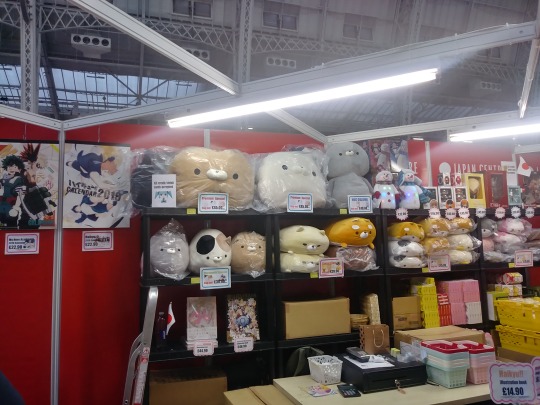
But of course, since this is after all a food blog, let's talk about the food. At the very beginning, I was collected from the front desk by two charming women from Fourteen Ten. We headed immediately to The Ramen Experience, where I was given a choice between shoryu, paitan and tonkotsu style ramen, and a chance to sample all three before deciding on which one I was to have in my bowl. Each comes from a different region, and each is distinct in flavour and mouthfeel. Shoryu, or soy sauce, was rich and roasty, effortlessly smooth and slightly sweet. Paitan, which, on the website was described as a chicken-based soup, was in person labelled as seafood stock. Either way, it was remarkably unfishy, and had a prominent, pleasant taste of both fresh and roast garlic. Tonkotsu is the neighbourhood darling style, a milky-cloudy broth made by cooking bones and feet for dozens of hours. A good tonkotsu should be gutsy, slightly thick, impossibly creamy and pure tasting. While the one I tasted was perfectly adequate, it did not live up to my expectations about what tonkotsu ought to be. As a result, I had a delicious bowl of shoryu ramen, with both gari, aka pickled ginger, and something that tasted like yacai, Szechuan pickled mustard greens (sour, slightly funky, a little bitter and lightly spicy) and along with the obligatory slice of chasu. Despite that the noodles lacked much of a bounce or snap, and the chasu wasn't fatty enough for my taste, it was a bowl worth finishing. That sounds like a lot of criticism mixed in with some faint praise, but no, outside of a couple stylistic choices, it was a bowl I'd be more than happy with at a restaurant, and would have been proud to make at home (I've tried making ramen. I've followed Binging with Babish's method, J Kenji Lopez Alt's version, and the edition found in Japanese Cooking: A Simple Art, whose title is possibly the biggest lie ever told. All of them were difficult, all of them were an obscene amount of work, all of them were frankly not worth the effort. If I find a method that works and doesn't make you want to die, I'll be sure to let you know.)

After that, the Fourteen Ten people let me loose on the stalls. I wandered past a woman selling EGL (Elegant Gothic Lolita) fashion, several weapons salesmen and a very busy stall selling manga both in the original and translated. Nearby, there were tables groaning with dolls and plushies, and there, over the way, were dakikamura, or body pillows, featuring characters from the Boku No Hero Academia anime. On the main floor, there was a condensed area where Japanese designers, artists, and craftspeople sold beautiful things, such as calligraphy, immaculate flowers made of silk, and shamiasen, traditional stringed instruments. I asked the person running the shamiasen stall if I could touch, and she leaned forward, rested a single finger on its body, and gave me a thumbs up. In short: no. I managed to get (very brief!) interviews with four different stallholders. I felt that since I was there, I might as well go do some journalism. I got brief peeks into the minds of two artisans, and one of the husband-and-wife teams selling swords, axes, and blades of all kinds:
The weapons sellers, Lee and Catherine, used to be in the business of selling replica toy handguns, until the law changed (presumably following the Dunblane massacre but neither mentioned it and nor did I). When that happened, it made replica guns a lot harder to sell. So instead, they moved on to selling swords, and especially movie replicas. It only made business sense for them to go to Comicon. Catherine's favourite is a massive bastard from World of Warcraft, while Lee favour's LOTR's Andruil. They don't think that any of their wares ought to be used for anything other than ornamental purposes, though you could technically use them for bushcraft.
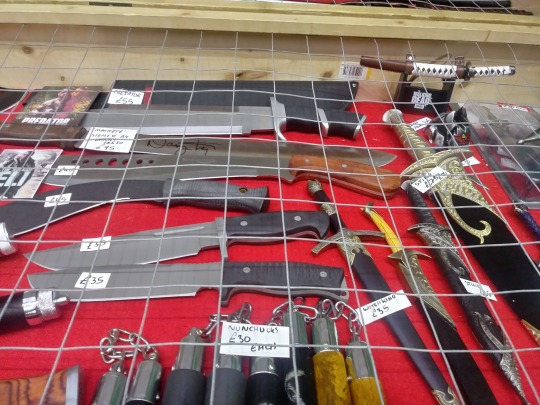
The next pair I spoke to were Tomoko Kuroda, and her friend Yuko. Since their design heavily featured a pair of cats, one black, one white, named Alain and Jean, I asked whether they belonged to them, and about their personalities. While Alain and Jean aren't their real names, they are indeed their cats, and the characters of the globetrotting gatos – ones that are “curious and fickle, but very fussy with their travel items”. have existed for two years. Kuroda collaboarated with the famous artist/illustrator called Masako Hirano. A fact about each cat is that Alain is very interested about everything and very positive, while Jean is sensitive and naive, and likes to study hard. However, according to the info card I received, “Our effort to analyse their psyche might be pointless but this is our pleasure and mission nevertheless. This interpretation of the world seen by cats' eyes is our unique brand story.” Here, here!

You can find their e-boutique here.
While many people have heard of origami, comparatively few know about kirigami. I had the privilege of speaking to Susumu Yamayoka, who won the Grand Prize for the Charming Japanese Souvenir Contest back in 2011 for his City Postcard kirigami series. Kirigami is the art of paper-cutout. Yamayoka's series celebrated traditional Japanese scenes in aching, intricate detail – unsurprising, since Yamayoka told me that he's been doing papercraft for the last two decades. It took Yamayoka two months to design four postcards.His website is here
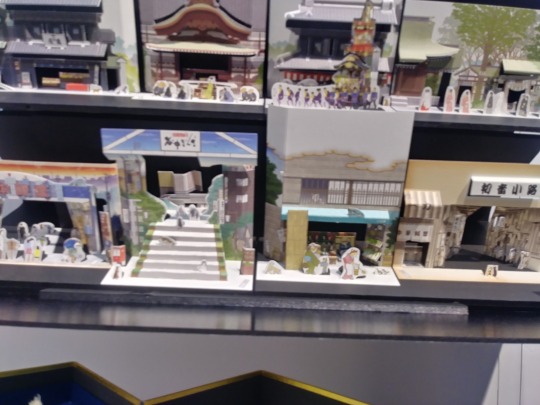
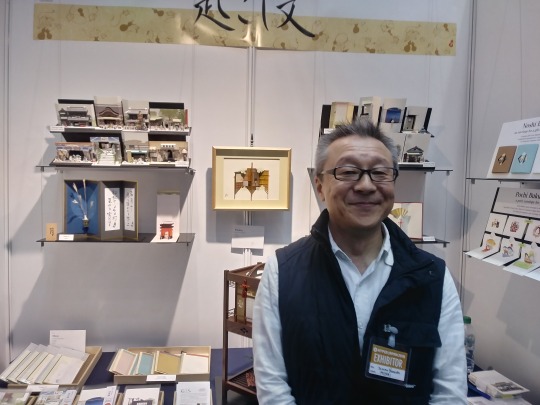
While there were many other stallholders, demonstrating mastery in mulberry-paper bookbinding, and watercolours, I did not have time to interview them all.
Then, I made a nice trip into the grimy speakeasy at Hyper Japan known as The Sake Experience. You rocked up, received about sixteen drinks tickets and two snacks tickets, and waddled around from table groaning with artisanal handmade drinks to table groaning with artisanal handmade drinks. Now, for those who've not had a sake experience, let alone The one; sake is a fermented rice beverage with a taste that uninitiated westerners may find quite unfamiliar. A good way to describe it is “like a grassier, fruitier dry sherry”, but since there are as many styles and traditions in sake brewing as there are in, say, French winemaking, the description I gave is insufficient. Another point about sake is that it can be drunk hot or cold. I remember saying when I was fourteen, having tasted my first hot sake, I said it tasted like “warm, unminty mouthwash”. It probably wasn't good stuff, but, as with many things, it's an acquired taste. I imagine that a mug of warm sake on a howling and bitterly cold Nagoya night would be comforting. As for the process of making sake, it involves inoculating cooked rice with Aspergillus oryzae, known in Japanese as koji, a fungus that transforms starches and sugars found in rice into alcohols. It's absolutely nothing to be afraid of, it's the rice edition of our homegrown hero, Saccharomyces cerevisiae, without whose noble efforts we'd never slug down a sixpack of PBR again – not that PBR has much of a future in our world. Cooked rice, koji, water, yeast and lactic acid are combined – at least in sake-houses that forsook the old way of doing things, where the rice and koji mixture is pounded to a paste – and the resultant mixture fermented. This is then pressed to remove unfermented solids, filtered once more, and then left to mature, like one would with wine.
For absolute beginners, I would suggest investing in a bottle of Shochikubai Shirakabegura Mio Sparkling Sake, not just because it doesn't have that much of a challenging koji flavour, but because it's significantly nicer than cat piss cava or bland prosecco. It has a gentle fragrance, is just the right side of sweet, and the carbonation adds both a sour note and makes it feel more refreshing. It isn't brut like champagne, more, a gentle, friendly face to pick up for a pleasant night in. I had the luck of picking up a bottle for £4 at the event – they were practically giving it away.

For those still a bit too afraid, there are a wide variety of Japanese fruit liqueurs. These often aren't like schnapps or are lighter fluid with a few drops of synthetic peach essence. Many Japanese fruit liqueurs, such as umeshu, have an ABV of about 12%. Umeshu is made by soaking whole green plums in grain alcohol, which is consequently watered down and sweetened. A different liqueur that I had the pleasure of drinking at Hyper Japan was Yomeishu Pink Grapefruit and Ginger (top); “precisely what it says on the tin!”, according to my tasting notes; a lusciously smooth and mild bev, tasting of real – if candy-sweet – fruit, like a boozier, top-quality alcopop. It was only later that I discovered that Yomeishu's flagship is a TCM (I use the “C” here generically) herb liqueur containing, of all things, the processed skin and organs of the mamushi pit viper, Gloydius blomhoffii. Unfortunately, I did not taste the snake tonic since it wasn't on offer, but had it been, I would probably have declined because I don't want to drink snakies. Nevertheless, snake-flaying aside, the good brewers at Yomeishu can make a lovely drink. The one umeshu I sampled , Urakasumi (buttom), was “bracing[ly] plummy” with an “almond bitter aftertaste”. As I don't have considerable umeshu experience, it was perfectly nice.

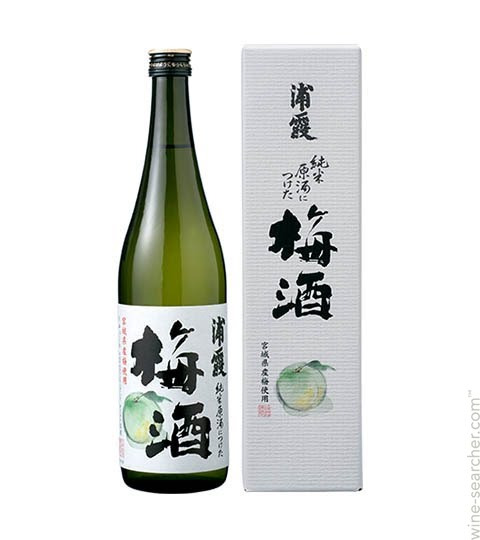
There were other types of sake on offer, such as the Yamabuki Gold, an aged sake, or koshu. The difference between a younger sake and a koshu is rather like a tequila blanco and añejo: the aged edition acquires a bronzeish colour and a deeper, often honeyish taste. I described the 7-time-in-a-row International Wine Challenge gold winner as having a “burnt toffee” character, “hypersmooth”, and with a “savoury aftertaste.”
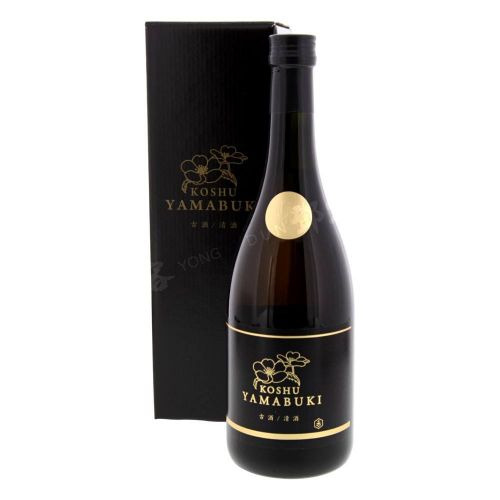
On the complete opposite end of the spectrum was the Junmai Ginjo Sachihime Dear My Princess, charmingly subtitled in block capitals with ALL THE BEST WISHES FOR YOUR FUTURE LIFE. I described the unpasteurized sake from what is apparently the smallest brewery in the Saga prefecture (found on Kyushu, the southern island making up Japan proper) as “sweet, creamy, esteric and smooth.” Following some basic research into sake tasting terminology, this “esteric”- or “fruity” quality is also known as ginjo, which is the resulting fragrance from the slow and low fermentation of rice whose exterior is mostly removed. Two compounds that contribute to ginjo fragrance are isoamyl acetate, well known to any brewers in the audience to being one part of the duo in many Hefeweizens, the other being clove. Due to my experiencing isoamy acetate almost always in conjunction with the phenolic compounds that made up clove, I iniitally had written down “phenolic” instead of “esteric”, and then had second thoughts as I noticed more classical fruit elements evolve, such as ethyl caproate – another ginjo component – which is common in many fruits, including apple and pineapple.

There were, oddly enough, what appeared to be luxury bottled tea., from the imaginatively named The Tea Company. It's here where I ran into the absurdly fashionable and intimidating woman from the Tea Authority. She recommended the Thé D'Or Gyokuro, which turned out to have “excellent clean bitterness”. It was a “very green” green tea, with a pleasing “sprightly slight salinity”. I preferred, however, the Ibushi, from the same label: it “tickles the throat”, had “topnotes of fruit, then smoke and malt”, and was “silken, bitter, refreshing and savoury”. The tea used to make the Ibushi was apparently smoked over Japanese cypress. Do I approve of bottled tea costing between £11 and £30 per bottle? I honestly have to say, even if it was absolutely delicious tea, that I can't.

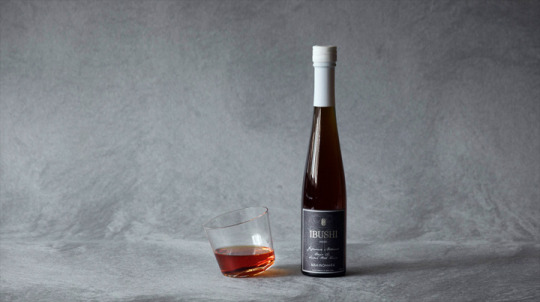
Finally, there were two spirits I tried. One was the Satsuma Shiranami, which is a spirit made from sweet potato- and it sure tasted of it: “earthy, nutty, popped rice, sweet but not sugary, and filling” is how I described it. This would in my mind be a fantastic addition to a hot toddy or pre-Christmas lunch drinks. The second is something I don't anticipate many of you ambling out of your wells to get, but I'll rec it anyway: the Kyoya Shuzo Yuzugin, combines two things that unsettle many people: gin, our proudest spirit, and Japanese botanicals, which can not be to everybody's tastes. Unsurprisingly, it had a deep, floral, long-lasting yuzu fragrance, and remarkably, I noticed a light tongue-buzz feeling, due to the sansho peppercorn. I won't fully get into this now, but the short is that the fruit of the Zanthoxylum trees produce compounds called sanshools, which give an anaesthetic, electrocuting, tingling, numbing sensation, most prevalent in Szechuan cooking, and one that I adore. Sansho peppercorn is Z. piperitum while good ol' Szechuan peppercorn is Z. simulans or bungeanum. While overall I can see more applications for the Satsuma Shiranami, not just in drinks, but as a nice thing to spin around a highball glass while relaxing, as one does when one is 23, if you like both yuzu and gin, and manage to find a bottle, go get it. Also, the bottle's pretty.
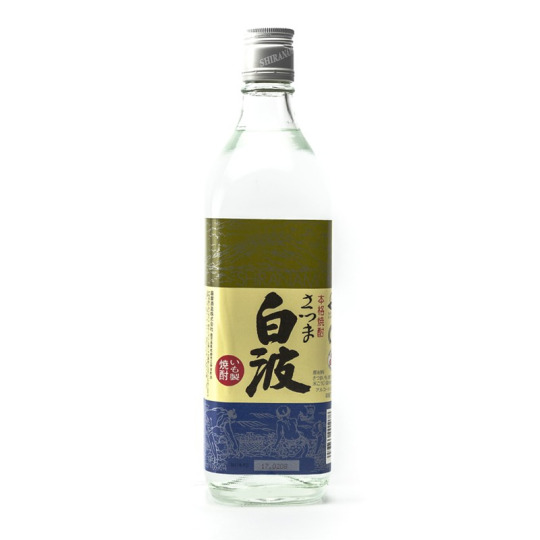
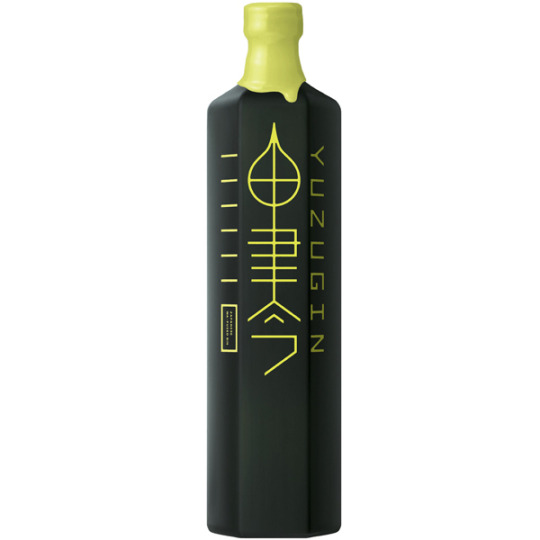
In the drunken stupour that tends to accompany having too many small drinks, I stepped outside and saw a stand selling three of my favourite Japanese snacks: takoyaki, sweet potato korroke and karaage. I got three for three, and sat down heavily in a chair, and watched the crowd pass me by as I had my snacks. Takoyaki is an orbular delicate wheat pancake, filled with chopped octopus. Mine were decorated traditionally, with aonori, aka green laver, mayonnaise and a sweet-savoury glaze made from Worcestershire sauce and reduced sake, soy sauce, mirin, kombu, and katsuoboshi (shaved dried bonito tuna). I like them because they have a wonderfully crunchy outside, and the inside is still kinda like a just-underset egg yolk or slightly underdone pancake batter, or a bechamel sauce. I think it's obscenely delicious, and was thankful at the paucity of octopus bits in the ones they gave me.

Karaage is a deep frying technique different from the better known tempura. In karaage, marinated pieces of meat, most usually chicken, are tossed in potato starch and deep fried until crispy. These had a crusty, gloriously msg-laden shell with tender pieces within. The crust had big crumbs in it, lending a nice variation in texture.
Korokke is a Japonification of “croquette”, where usually mashed potato is stuffed with a filling, rolled in panko, and deep fried. These ones were pure sweet potato, and utterly fantastic. I have a long-held suspicion that the Japanese sweet potato cultivars tower head and shoulders above those grown anywhere else. They tend to have the most amazing chestnutty taste and yielding texture. These were no exception. The korokke were “fudgy” and satisfying, the panko crust so ethereal, it might not have even been there. Of the three fried snacks, they were without a doubt my favourite.
In short, I did not eat or drink one thing on Friday that wasn't delicious, and there were a few that were completely exceptional.
As I walked back from Kensington Olympia to take the bus home, I thought about how I'd been exposed to so many different aspects of the culture of another somewhat strange, tea-obsessed island, and how valuable it was that events like Hyper Japan are put on; raising awareness in not just the more massively marketable aspects of another culture, but their unique traditions also. I had a great time. Since it's now over, I honestly can't wait for the summer one!
3 notes
·
View notes